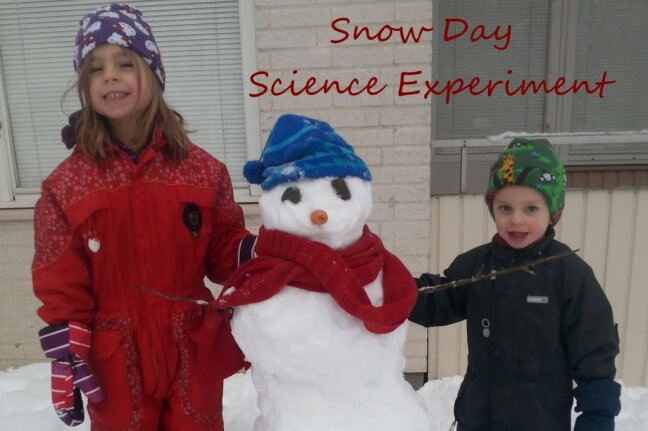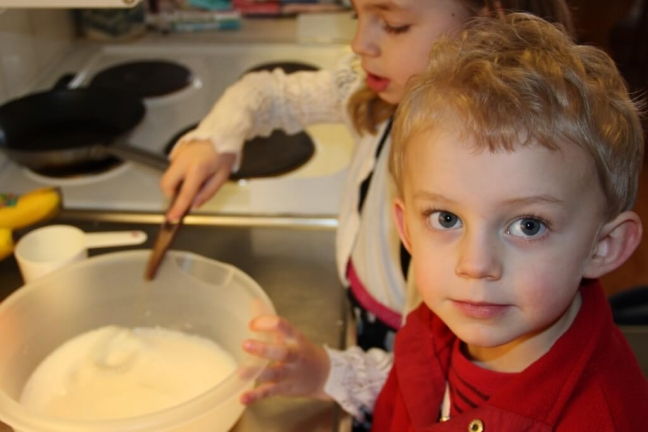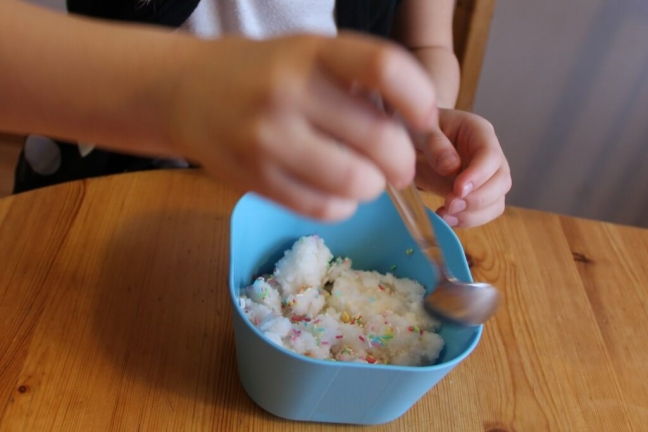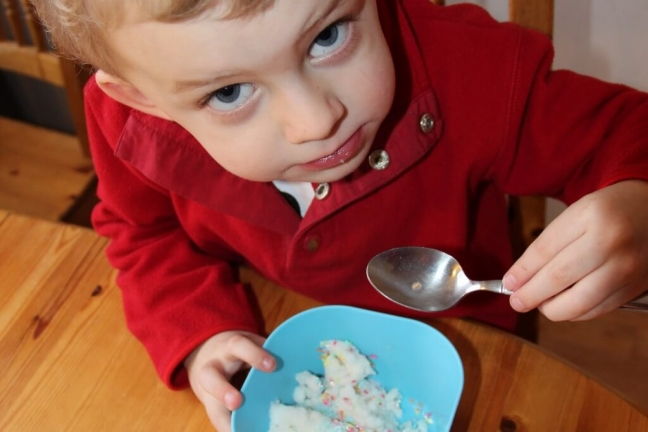We live right around 65° N latitude in the north of Sweden. If there’s one thing we know we can count on it’s snow in the winter. But even if you live a bit further south, a good winter storm can be a great excuse to take a break from routines and try some snow-centered learning at home. Kids have a natural wonder and curiosity about this fluffy white stuff, even our kids who have every reason to see it as commonplace. So why not capture a bit of that excitement and learn a little something along the way?
Our kids love science experiments. I think most kids do! So our suggestion to do a science experiment was met with lots of jumping up and down and clapping. Today’s challenge: Can you find the places in our apartment where snow would melt the fastest? How about the slowest?
Planning our Placement
We got five scoops of snow and brought them inside. But before we did that, they got to take turns choosing where to place each scoop, and say how quickly they thought it would melt.
Emelie chose first: the freezer. “I think it will melt slowest in the freezer because it’s cold in there.”
Peter’s turn: “In my mouth. It will melt fast in my mouth.” Okay, why not?
Emelie’s turn again: “In the refrigerator. That’s also cold, but not quite as cold as the freezer. It will melt slowly in the refrigerator.” Sounds good.
Then Peter: “In my nose.” Hey, he got a good reaction to the mouth suggestion. And he’s 3. We encouraged him to think of someplace else. “In my ear.” Okay, how about a place that’s NOT on your body? “Um, in a boot. Boots keep our feet warm so it will melt the snow.” Slightly stunned silence from both parents. Okay, boot it is.
Back to Emelie, who is now clearly inspired to join her brother in thinking outside the box. I asked if she thinks we’ve found the place in our apartment that it would melt fastest. Boring adult that I am, I’m thinking about the stove, the oven, or maybe the microwave. “Okay, so we take a glass and heat it up with something and then we put the snow under the glass. That will melt it fastest.” Under the glass or in the glass? “Under. Like we put the snow on the counter and put the glass over it.” Hmm, okay. And what should we use to heat up the glass? “I don’t know. Do we have a fan that blows warm air? I think we want to blow on it.” Like a hairdryer? “Yes! A hair dryer. And then while the snow is under the glass we keep blowing the hairdryer on the glass to keep it warm. That will melt it really super fast.” Ok. Sounds like a plan. Now we have 5 places.
Recording our Results
It’s very important, of course, when you’re doing an experiment to test your hypothesis that you have a good way to record your results. We decided together to make a chart with our 5 places, and in what order they melt, fastest to slowest. First we wrote out our predictions, then left space to write what really happened. Mamma made a traditional-style chart with just words. Emelie’s chart used words and pictures, and color-coded the predictions and actual results. Peter’s was all pictures, with a few extra happy faces and things added in.
Emelie’s hypothesis: 1. hairdryer/glass 2. mouth 3. boot 4. refrigerator 5. freezer
Peter’s “hy-pop-esis”: 1. mouth 2. hairdryer/glass 3. boot 4. refrigerator 5. freezer
Finally it was time to get the snow and test our hypotheses!
Let’s Bring in the Snow!
Two scoops went into bowls and went right into the refrigerator and freezer. One scoop when directly down in a boot (we chose one we don’t use as often, since it was going to get wet inside!) Then Emelie and I got to work with the hairdryer on the glass, while Pappa spooned a bit of snow onto Peter’s waiting tongue. When Emelie saw how fast the snow on Peter’s tongue melted, while the snow under the glass hadn’t melted much at all yet, she decided the glass was the problem. She decided to blow the hairdryer directly onto the snow. It melted much faster this way, but still much slower than the spoonfuls going into Peter’s mouth. At least it was fun making a mess, blowing melting snow all over the counter with the hairdryer!
One scoop of snow in the freezer
And another one in the refrigerator
Here comes the boot!
One snowball in a boot
Melting snow in his mouth
We recorded our results with the first two, then checked in with the boot, refrigerator and freezer. Still snow. Slowly the snow in the boot melted and we eventually wrote a 3 on our charts there. Much later in the day, the snow in the refrigerator was melted and we recorded the number 4. The snow in the freezer is still in there, many days later.
Celebrate Success!
We celebrated our success by making vanilla snow ice cream with rainbow sprinkles!
Measuring and mixing ingredients for snow ice cream!
Mix in the snow and add some sprinkles!
Yum!
This was a simple experiment that didn’t require too many supplies or advance planning. It wasn’t only a chance to study how snow melts, but it was a great introduction to basic scientific method and thinking: forming a hypothesis, testing a hypothesis, recording results. I’m glad I let the kids pick the places, rather than choosing them myself in advance, for several reasons.
First, the kids had ownership of this experiment in a different way. Their hypotheses where not just about the speed of melting but they were thinking about the properties of different places and things. Where they disagreed with each other, there was even a bit of competition involved, which increased motivation even more.
Also, their ideas brought us into a deeper discussion than I would have initiated on my own. I would have stuck to differences in temperature but they got us talking about how wet or dry effected melting speed (hair dryer v. mouth) and even a bit about insulation (why the glass changed the effect of the hair dryer and why the boot melted so much slower than they’d thought). I wouldn’t have brought this into the discussion at the preschool/kindergarten level, but it went well because it came out of their own ideas and interest.
Lastly, it was much more fun! I consider myself creative but their imaginations are on a whole different level. I had never pictured us spooning snow into our mouths or chasing it across the counter with a hair dryer, but these were some of the best moments of the day!









